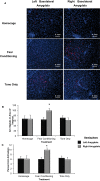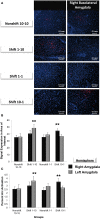Differential activation of amygdala Arc expression by positive and negatively valenced emotional learning conditions
- PMID: 24367308
- PMCID: PMC3852216
- DOI: 10.3389/fnbeh.2013.00191
Differential activation of amygdala Arc expression by positive and negatively valenced emotional learning conditions
Abstract
Norepinephrine is released in the amygdala following negatively arousing learning conditions. This event initiates a cascade of changes including the transcription of activity-regulated cytoskeleton-associated protein (Arc) expression, an early-immediate gene associated with memory encoding. Recent evidence suggests that the valence of emotionally laden encounters may generate lateralized, as opposed to symmetric release of this transmitter in the right or left amygdala. It is currently not clear if valence-induced patterns of selective norepinephrine output across hemispheres are also reproduced in downstream pathways of cellular signaling necessary for memory formation. This question was addressed by determining if Arc expression is differentially distributed across the right and left amygdala following exposure to positively or negatively valenced learning conditions respectively. Male Sprague Dawley rats were randomly assigned to groups exposed to the Homecage only, five auditory tones only, or five auditory tones paired with footshock (0.35 mA) during Pavlovian fear conditioning. Western blot analysis revealed that Arc expression in the right amygdala was elevated significantly above that observed in the left amygdala 60 and 90 min following fear conditioning. Similarly, subjects exposed to a negatively valenced outcome consisting of an unexpected reduction in food rewards showed a greater level of Arc expression in only the right, but not left basolateral amygdala. Presenting a positively valenced event involving an unexpected increase in food reward magnitude following bar pressing, resulted in significantly greater Arc expression in the left, but not right basolateral amygdala (p < 0.01). These findings indicate that the valence of emotionally arousing learning conditions is reflected at later stages of synaptic plasticity involving the transcription of immediate early genes such as Arc.
Keywords: Arc expression; amygdala; amygdala lateralization; brain asymmetry; emotional arousal; memory modulation.
Figures







Similar articles
-
Valence dependent asymmetric release of norepinephrine in the basolateral amygdala.Behav Neurosci. 2010 Oct;124(5):633-44. doi: 10.1037/a0020885. Behav Neurosci. 2010. PMID: 20939663
-
PACAP increases Arc/Arg 3.1 expression within the extended amygdala after fear conditioning in rats.Neurobiol Learn Mem. 2019 Jan;157:24-34. doi: 10.1016/j.nlm.2018.11.011. Epub 2018 Nov 17. Neurobiol Learn Mem. 2019. PMID: 30458282 Free PMC article.
-
Post-training intra-basolateral complex of the amygdala infusions of clenbuterol enhance memory for conditioned place preference and increase ARC protein expression in dorsal hippocampal synaptic fractions.Neurobiol Learn Mem. 2021 Nov;185:107539. doi: 10.1016/j.nlm.2021.107539. Epub 2021 Oct 12. Neurobiol Learn Mem. 2021. PMID: 34648950 Free PMC article.
-
Physiological basis for emotional modulation of memory circuits by the amygdala.Curr Opin Neurobiol. 2013 Jun;23(3):381-6. doi: 10.1016/j.conb.2013.01.008. Epub 2013 Feb 5. Curr Opin Neurobiol. 2013. PMID: 23394774 Free PMC article. Review.
-
Role of the basolateral amygdala in memory consolidation.Prog Neurobiol. 2003 Aug;70(5):409-20. doi: 10.1016/s0301-0082(03)00104-7. Prog Neurobiol. 2003. PMID: 14511699 Review.
Cited by
-
The Insula and Taste Learning.Front Mol Neurosci. 2017 Nov 3;10:335. doi: 10.3389/fnmol.2017.00335. eCollection 2017. Front Mol Neurosci. 2017. PMID: 29163022 Free PMC article. Review.
-
Emotional modulation of synapses, circuits and memory.Front Behav Neurosci. 2015 Feb 19;9:35. doi: 10.3389/fnbeh.2015.00035. eCollection 2015. Front Behav Neurosci. 2015. PMID: 25745390 Free PMC article. No abstract available.
-
Dissociable roles of the nucleus accumbens core and shell subregions in the expression and extinction of conditioned fear.Neurobiol Stress. 2021 Jul 14;15:100365. doi: 10.1016/j.ynstr.2021.100365. eCollection 2021 Nov. Neurobiol Stress. 2021. PMID: 34355048 Free PMC article.
-
Disruption of Epithalamic Left-Right Asymmetry Increases Anxiety in Zebrafish.J Neurosci. 2015 Dec 2;35(48):15847-59. doi: 10.1523/JNEUROSCI.2593-15.2015. J Neurosci. 2015. PMID: 26631467 Free PMC article.
-
It Is All in the Right Amygdala: Increased Synaptic Plasticity and Perineuronal Nets in Male, But Not Female, Juvenile Rat Pups after Exposure to Early-Life Stress.J Neurosci. 2020 Oct 21;40(43):8276-8291. doi: 10.1523/JNEUROSCI.1029-20.2020. Epub 2020 Sep 25. J Neurosci. 2020. PMID: 32978287 Free PMC article.
References
Publication types
LinkOut - more resources
Full Text Sources
Other Literature Sources

